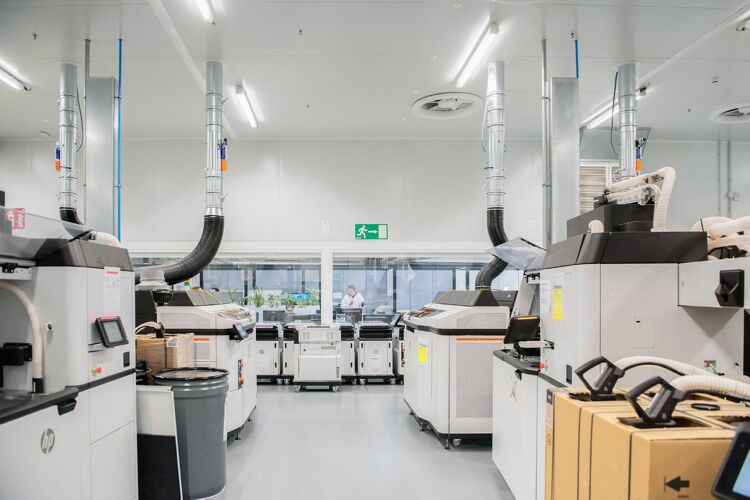Ford and HP partner on world-first 3D print initiative

Automotive manufacturing giant giant Ford has joined forces with HP on a new initiative that will see waste materials from 3D printing used to create car parts.
Through the collaboration, Ford and HP will use spent 3D printed powders and parts from HP’s 3D printers as the core material for injection molded parts for use in automobiles.
Specifically, the waste materials will be use to manufacture injection-moulded fuel-line clips for the Super Duty F-250 trucks. Ford has also said the process could be used to manufacture similar parts on a number of its other vehicles.
According to Ford and HP, this initiative will offer a number of major benefits, primarily that the reuse of the waste material will improve the environmental credentials of both businesses.
Ford also said the parts using recycled 3D print materials have better chemical and moisture resistance than conventional versions, while these parts are 7% lighter and cost 10% less than the more traditional parts.
“Finding new ways to work with sustainable materials, reducing waste and leading the development of the circular economy are passions at Ford,” Ford technical fellow for sustainability Debbie Mielewski said.
“Many companies are finding great uses for 3D printing technologies, but, together with HP, we’re the first to find a high-value application for waste powder that likely would have gone to landfill, transforming it into functional and durable auto parts.”
Ellen Jackowski, chief sustainability and social impact officer at HP, said that 3D printing already offers a more environmentally friendly alternative when it comes to manufacturing certain products, and the collaboration with Ford further demonstrates the technology’s green qualities.
“You get more sustainable manufacturing processes with 3D, but we are always striving to do more, driving our industry forward to find new ways to reduce, reuse and recycle powders and parts,” Jackowski said.
“Our collaboration with Ford extends the environmental benefits of 3D printing even further, showcasing how we are bringing entirely different industries together to make better use of spent manufacturing materials, enabling a new circular economy.”
The reuse process works with support from three other companies in the form of SmileDirectClub, Lavergne and ARaymond.
Oral care company SmileDirectClub operates the largest facility of HP 3D print systems in the US, with its fleet of more than 60 HP 3D printers producing over 40,000 aligners a day. Waste materials from the site are collected and recycled for repurposing.
Resin producer Lavergne, a long-term recycling partner of HP, transforms the molds and discarded powder from Ford’s HP 3D printers into recycled plastic pellets that are suitable for injection molding.
Finally, Ford supplier ARaymond, which designs, engineers and manufactures assembly systems, molds the pellets into fuel-line clips ready for use on Ford’s vehicles.
“A key to achieving our sustainability goals and solving the broader problems of society is working with other like-minded companies – we can’t do it alone,” Mielewski said.
“With HP, we defined the waste problem, solved technical challenges and found a solution in less than one year, which is something in which we all take pride.”
Discover the latest innovations in 3D printing at the Global Print Expo 2021, Europe's leading exhibition for screen and digital wide format print, textile printing and signage. Discover the latest products, network with like-minded individuals and explore new business opportunites. Register your interest here.
Topics
Interested in joining our community?
Enquire today about joining your local FESPA Association or FESPA Direct
Recent news

The importance of ink for large format printers
Ink is crucial for large format inkjet printers, influencing substrate compatibility, productivity, and cost. Nessan Cleary discusses the three main types which include UV-curable ink, latex ink and eco-solvent ink. Each ink type has specific strengths and weaknesses, making printers choice dependent on budget and intended applications.

What are the benefits of Direct-To-Fabric printing?
Direct-to-fabric printing is gaining popularity for high-volume textile production, enabling on-demand, customized short runs. These printers offer ink flexibility, accommodating various fabric types like cotton and silk, though ink development focuses on faster turnaround by reducing pre- and post-processing. Compared to traditional methods, direct-to-fabric inkjet printing is a more sustainable option due to reduced water and chemical usage, and localized production.

What are the opportunities for large format providers regarding digital touch screens?
Digital touchscreens are becoming increasingly common, offering businesses opportunities to improve customer engagement and streamline operations. Nessan Cleary shares, while more expensive to implement than standard digital displays due to complex software and integration needs, touchscreens provide self-service options, multilingual support, and can reduce staffing costs in various settings like retail, transportation, and healthcare.
